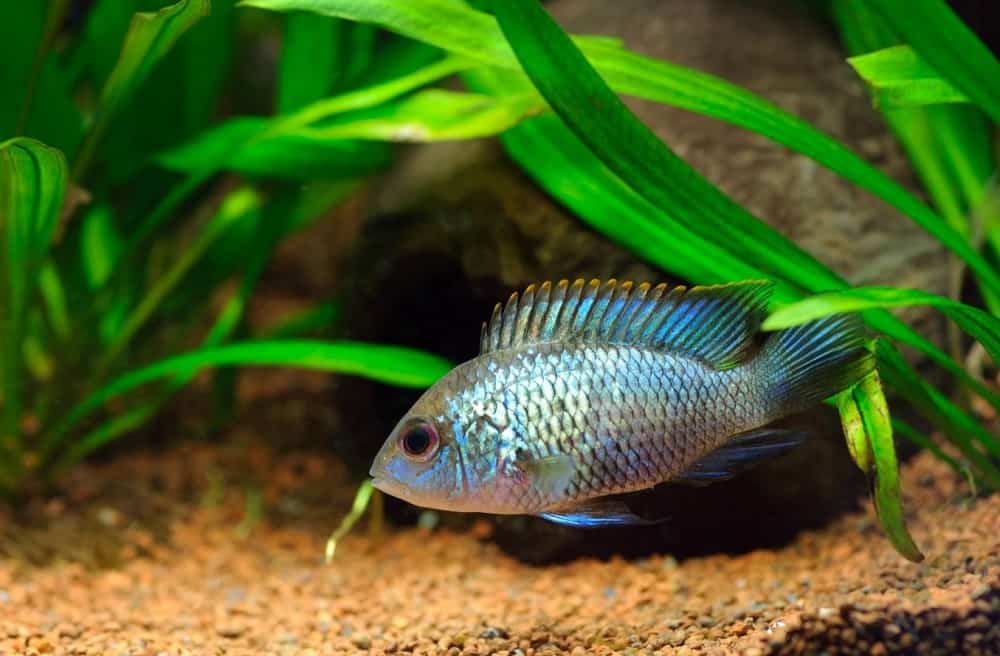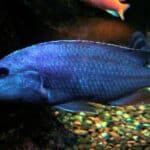If you are a fish enthusiast, and looking for some new breeds to add to your aquarium, then you will want to hear about the Blue Acara. This is one of the most popular freshwater fish in the aquarium community.
And, it’s no wonder why! These fish are a sight to behold, with stunning electric blue colors to catch your eye, and they’re super easy to manage and care for. They’re a great fish for experienced aquarists, or first timers. So, let’s find out everything you need to know about the Blue Acara.

Species Summary
The blue acara, or Andinoacara pulcher is a very bright, colorful and beautiful freshwater fish from the cichlid family. This fish can be located in many freshwater habitats from streams to standing water.
The Blue Acara actually originates from locations such as South and Central America and tends to live in slow-moving waters much like others in the cichlid family. Basically, you can find these little guys in any freshwater places such as lakes, streams and rivers.
This bright blue cichlid is ideal for beginners as unlike others in the cichlid family, it is not aggressive. Many cichlids are known to be defensive and aggressive, but the blue acara is not at all! They coexist peacefully with other tank mates, and have many compatible fish that they can reside with.
No matter who you pair these fish with, they will surely stand out in your aquarium due to their striking appearance!
Care Guide
Blue Acara are simple to care for, and are very easy to maintain, as long as you know how!
Tank Size
The recommended size for a Blue Acara is 30 gallons, as this provides enough space to remain active, explore the tank and swim around. If you want to add in Blue Acara, then add in an additional 15 gallons per new fish. So, if you have two, you will need 45 gallons.
Tank Mates
The Blue Acara gets on well with multiple species and will not show signs of aggression. That being said, do not place them with aggressive fish, or ones much larger than the Blue Acara. You’re best off keeping them with other peaceful fish such as Rainbowfish, Oscars, Discus fish, Cory Catfish, or Moga cichlids.
Same Species Tanks
Of course the Blue Acara will do best with its own kind. To keep them happy, always ensure that there is an even number of Blue Acara so no one gets left out. Keep them in lots of 2,4,6,8 or 10 for the best results. Also, they’ll look amazing together!
Water Parameters
You have to have good water quality to ensure your fish are healthy and thriving. The good news is that the Blue Acara is a very hardy fish, so you have a range of water parameters to stay within.
Water temperature should be kept between 72 degrees fahrenheit and 82 degrees fahrenheit, whilst the pH levels should be between 6 and 7.5. Finally, the water should have a hardness level of 6-20 dH.
What To Put In Their Tank
Blue Acara are very peaceful and easily manageable fish, but we advise that you put various things inside their tanks for them to enjoy, explore and nose around. To do this, it is best to try to recreate the natural environment in which they live.
For instance, they need lots of places to hide to give them a safe, secure place to chill out. They also love to dig, so it may be better to have a soft substrate that they can burrow into. They will also benefit from lots of vegetation and floating plants in their tanks.
Common Diseases
One of the most common diseases the Blue Acara will get is skin fluke and ich. Just make sure that the water is always clean and the tank is hygenic, and your fish will be fine.
Food & Diet
Food is vital in keeping your Blue Acara healthy. Depending on the quality of food given, and the amounts, you can ensure they are well cared for for longer. Their natural diet consists of live critters and plant based foods as these fish are omnivores.
Therefore, you should be feeding them protein such as earthworms, small insects, brine shrimp, bloodworms, along with plant based snacks. Although they will eat it, do not just give them protein as they need a balanced diet. You can also feed pellets and flake fish food as long as they are nutritious and full of protein.
You should also try not to overfeed the Blue Acara. All they need is two meals a day, and make sure that it is only enough for them to eat in a few minutes. Dispose of any food that is left after this time. If it takes them longer than four or five minutes to eat, then you are giving them far too much and overfeeding them.
Lifespan
On average, the Electric Blue Acara has a lifespan of about 8-10 years when kept in captivity. If left in the wild, a blue acara can live twice as long as that! With proper care and attention, your electric blue acara can live a long and healthy life.
For instance, the lifespan of your blue acara, and many other fish for that matter will be affected by things such as poor water quality, stress, and poor living conditions. If you ensure that they have enough space, food, clean water, and keep the tank hygienic at all times, they can live much longer.
One of the greatest appeals of owning the blue acara is its lifespan, as you will get a lot of time to bond and care for the fish.
Appearance
The blue acara typically has a very stocky yet compact body, with long fins that flow around them. The main body is typically blue, with hints of blacks and browns depending on the location of the fish.
They are often referred to as the electric blue acara, which is incredibly apt and suited to them, due to their bright, eye-catching color and appearance. They can sometimes even look as if they are glowing in a neon color, they are so bright and shiny.
This may be why they are such popular aquarium fish, due to their desirable appearance. Most blue acara have a light, shiny blue color that tends to glimmer in the light. However, you will notice some faded yellow colors on the side of their bodies, along with a little yellow towards the front half, and along the dorsal fin.
The dorsal fin of the blue acara also starts about a quarter of the way back from the front of the body, and extends towards the caudal fin.
The blue acara can also be recognized by a distinctive dark, black line that goes from the eye to the cheek, which is a mark that is not often found on other cichlids.
Size
When it comes to size, the blue acara is generally between 5 to 7 inches in length. The blue acara is therefore a very decent and manageable sized fish, which makes it a great addition to your home aquarium. These fish are easy to keep in a fairly average sized tank, and will be a wonderful addition to your aquarium.
Behavior & Temperament
As previously stated above, the Blue Acara is known to be far less aggressive than other cichlids in the family, and are nowhere near as defensive or aggressive towards other fish like the Jewel cichlid or African cichlid.
What this means is that the Blue Acara can be housed with a variety of tank mates without any problems, aggression or disturbances in your tank. Due to their very easy going and calm temperament, they are very easy to care for and maintain.
When it comes to behavior, the Blue Acara is a fish that you will love to have. They are very inquisitive and curious, making them a joy to watch. You will notice that the Blue Acara thrives off exploring and foraging around their tank. They will examine and investigate everything around them!
The Blue Acara also enjoys digging and rummaging through everything it can find, looking for new things to nibble on and roor through. Other than that, they are very chilled, calm and peaceful creatures that will behave very well inside of your aquarium.
Breeding
Breeding these beautiful creatures is very simple, so much so that anyone could do it. These fish are so relaxed and calm, that they have a high success rate with breeders. After the Blue Acara is fully grown, to about 5 inches, they will be able to start breeding.
The only thing you have to keep in mind is that the Blue Acara mates for life, so you will not be able to breed them with others after they have been matched once.
It is also a good idea to have a separate breeding tank when you want to breed the Blue Acara. This can be smaller than a normal tank to ensure that the fish want to breed. We recommend using a 20 gallon tank with a temperature of about 75 degrees fahrenheit for the best results.
You can also spot when a pair of Blue Acara want to mate, as they will spend much more time together than normal, and will start to interact with one another. When the mating process begins, they will be more active at the bottom of the tank, so it is a good idea to place soft substrate such as sand in your breeding tank.
Once they have found a clean spot at the very bottom of the tank, the female will spawn her eggs, and the male will fertilize them. Once this is done, the male and female Blue Acara will watch the eggs after fertilization has taken place, ready for them to hatch.
It is only at this point that the Blue Acara may become aggressive, which is why they should be bred in a separate tank to prevent any problems.
Gender Differences: Male vs Female
In most cases, the male Blue Acara will develop an elongated dorsal, and anal fins as it gets older. On the other hand, the female will keep her short, rounded fins.








